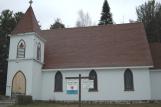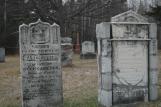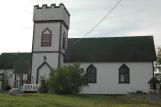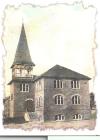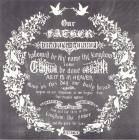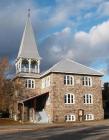1
In 1851, missionary Reverend George McDougall, based in Garden River, would travel to Bruce Mines for monthly services, which were held in a small chapel. The Cornish people of Wesleyan Methodist faith built this chapel soon after their arrival in Canada. For a period of time the Methodist, Anglican, and Presbyterian faiths all worshipped together.3
St. George's Anglican Church was built in 1881 on Taylor Street and consecrated on October 23, 1884 by Bishop Sullivan. The pews and furniture were all handmade and are still in use now. The original lighting was provided by power, generated from a power plant owned and operated by the mining company. Once the mines closed, this power source was no longer available. The church used oil lamps, then gas incandescent lamps, and finally in 1945 its present lighting system was installed. The original heating source was a wood stove, then an oil space heater, and in the 1950's an oil furnace. The rectory was built in 1910 and still stands. St. George's Anglican Church was closed in the fall 2004 due to plumbing and heating problems. The small congregation now travels to the Church of the Redeemer in Thessalon, 18 km (12 miles) away.6
In 1894 the Presbyterians built their own church, which was referred to as the "Church on the Rock". After 1917 it held the post office and was later used as a church hall, Scout hall, and from 1945 until 1948 as the Continuation School. In 1950 the Chamber of Commerce purchased the building and converted it to a museum, which was opened in 1961 with Reuben Beilhartz as its first curator.8
The Wesleyan Methodists purchased an old building, originally used by a multitude of different Methodist groups, located on the site of the present day United Church. As the congregation grew, and the Methodists in Canada amalgamated, plans for building a new church were drawn up. While digging the foundation for the new church, they found, what is believed to be, the original communion service. Finally, despite a severe winter storm, the church was officially opened on February 4, 1906, with 2000 people attending three services. In 1917 the Methodist and Presbyterian congregations agreed to a local merger and began worshipping together in the same church. In 1925 the church became part of the United Church of Canada, and is still in use today.Photo courtesy of the Bruce Mines United Church.
10
This huge carving (around 3' x 3') of the Lord's prayer holds a place of honour in the front of the Bruce Mines United Church.The prayer was carved, from 42 pieces of wood, by Charles Smedley of Toronto. He presented it as a wedding gift to his daughter, Esther Maude, when she married James Samuel Dobie in 1898. Mr. and Mrs. Dobie donated the carving to the newly constructed Bruce Mines Methodist Church in 1905.
Photo courtesy of the Bruce Mines United Church.
12
The Centennial of the Bruce Mines United Church was celebrated in October 2005.2005 was also the fifteenth anniversary of the Journey of Love, more commonly known as the Holy Walk. A popular, annual event recreating the journey of Mary and Joseph to Bethlehem.
Photo courtesy of Bill and Donnie Love.
13
Banner celebrating the Bruce Mines United Church Centennial.2005
Bruce Mines United Church, Bruce Mines, Ontario, Canada

